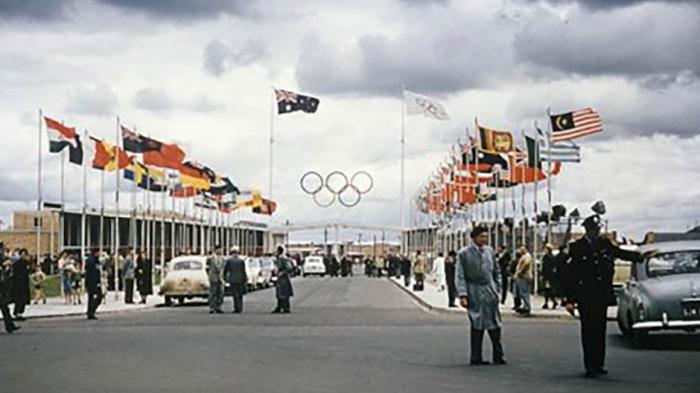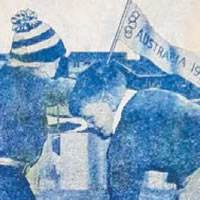Olympic Village | Heidelberg 1956 |

The Olympic Village was built in Heidelberg West as accommodation for the 1956 Olympic Games held in Melbourne, Victoria, Australia.
The Olympic Village was built to house athletes competing in the 1956 Olympic Games, was designed as a series of 841 individual dwellings which could serve as future housing accommodation, rather than the barrack-like structures used in previous Olympics.
The Olympic Village bounded by Southern Road, Oriel Road, Dougherty Road and Liberty Parade, Heidelberg West included shops, restaurant and recreation hall, as well as large temporary buildings housing dining rooms, saunas and a bank.
The Village was home to almost 5,000 athletes and officials from 57 nations. This was an unusual athletes' village. Traditionally, Olympic teams had been housed in dormitories; here, they were allocated semi-detached houses and flats.
For the first time, women and men were housed in the same area, with only a fence to separate them. Legend has it that when male footprints were discovered on the women's side of a fence, an investigation revealed that a Greek pole vaulter in search of female company had simply leapt the fence.
The athletes
I met all the famous athletes like Dawn Fraser, Lorraine Crapp, Shirley Strickland, Betty Cuthbert & Marjorie Jackson. I remember that Murray Rose was the only athlete not to stay in the Olympic Village because he was on a special diet.
I can recall all the crowds of people lining up outside for autographs and one of the athletes said to me 'I can't understand all the fuss we're just like everyone else, just normal people. But I told her that this was probably the only chance that someone would get to meet a real Olympian, it was a fantastic experience.
There also wasn't any security like nowadays although I do remember that IRAQ would not eat in the same kitchen as Iran and ended up leaving. At the end of the games even though we were volunteers, we did get paid about 3 pounds a week and we also got a special letter from Canberra. wikinorthia.net.au
Video
This clip from Olympic Postscript, a film produced by the Postmaster-General's Department, shows the postal and telephone services in the Olympic Village.
After the Games
The area in Heidelberg West is still called "Olympic Village".
About 600 of the houses were used for public housing. The area now consists of a sports center, a primary school, shopping strip, a community health centre which also houses a registered training organization and a legal service.
In 1995 the State Government and Banyule City Council initiated an Urban Renewal and Revitalisation program, which transformed many houses that had fallen into disrepair.
Doing it tough together: Melbourne's Olympic village community
In 2015, ABC Radio broadcast a marvellous series of interviews with resident Maxine who proudly introduced the Olympic Village of today.
Nearly 60 years after Melbourne hosted the Olympic Games, those living in the former athletes village still suffer the effects of a rushed development and public housing policies of the time.
774 ABC Melbourne
By Clare Rawlinson
Book
Nation with nation: The story of Olympic Village Heidelberg,
Olympic Games Melbourne, 1956
Authur: Geoffrey Ballard
Spectrum Publications, Melbourne, 1997.
Tells of the organisation required for the establishment of Olympic Village and the hosting of the international guests.
Moving Forward
How about an information centre / museum?
How about information plaques outside each residence explaining who stayed there during the games?
Answer: Are the the Olympic rings over the entrance to the original Village the original rings as we heard they were moved to a wall at Banksia Secondary College.
 No-one had a better view of Melbourne's Olympic Village emerging in time for the 1956 Games than Col Osborne and his six siblings.
No-one had a better view of Melbourne's Olympic Village emerging in time for the 1956 Games than Col Osborne and his six siblings. The lucky Osborne kids had front row seats to the biggest show in town as they watched the village being built over their back fence in Heidelberg West.
And by a stroke of luck, a photographer captured the family's enviable vantage point for this serendipitously timed newspaper soap powder advertisement for The Sun News-Pictorial in September 1956.
Once the Games began, Col and his siblings were fortunate enough to chat over the fence with some of the international competitors who were staying in the village.
"At the back of our house we had Olympic weightlifters in their early 20s from one of the Baltic countries," says Col, 67, now living in Watsonia North.
"They couldn't speak English but they still came to the fence to say hello.
"To show how strong they were they bent metal pipes in front of us. Us kids were all pretty impressed!"
The Osbornes were chosen to promote soap powder brand Rinso in the lead-up to the Games after Col's mother was stopped on the way to the supermarket with the kids and a pram full of groceries.
Mrs Osborne was asked about her large family and was given a year's supply of Rinso, for which she was understandably grateful.
"Mum was also paid £10 to do the ad for Rinso, which back then was a small fortune in our neighbourhood," Col says.
The family of nine lived in a three-bedroom home in what was one of Melbourne's poorest suburbs.
Col, aged two at the time, can be seen in the main photo receiving a helping hand up from one of his older brothers.
While Col was a little young to understand all the fuss, excitement was at fever pitch for his older siblings as the Games approached.
In the ad, Col's 12-year-old sister, Lynette, says: "Nine to wash up after - and then homework! But with Rinso we race through the dishes like Landy."
This article by JEN KELLY is from the July 20, 2021 issue of The Herald Sun Digital Edition. To subscribe, visit https://www.heraldsun.com.au/.
❊ Web Links ❊
➼ Olympic Village | Heidelberg 1956
➼ www.facebook.com/LostMelbourne
➼ The Olympic spirit of West Heidelberg
➼ Banyule City Council | banyule.vic.gov.au
➼ 1956 Olympic Games Reflections
➼ Book: Nation with nation | Geoffrey Ballard
➼ wikipedia.org/wiki/Heidelberg_West,_Victoria
➼ wikinorthia.net.au/heidelbergs-olympic-village
Disclaimer: Check with the venue (web links) before making plans, travelling or buying tickets.
Accessibility: Contact the venue for accessibility information.
Update Page








